
The Texas State Capitol is the capitol and seat of government of the American state of Texas. Located in downtown Austin, Texas, the structure houses the offices and chambers of the Texas Legislature and of the Governor of Texas. Designed in 1881 by architect Elijah E. Myers, it was constructed from 1882 to 1888 under the direction of civil engineer Reuben Lindsay Walker. A $75 million underground extension was completed in 1993. The building was added to the National Register of Historic Places in 1970 and recognized as a National Historic Landmark in 1986.

The Minnesota State Capitol is the seat of government for the U.S. state of Minnesota, in its capital city of Saint Paul. It houses the Minnesota Senate, Minnesota House of Representatives, the office of the Attorney General and the office of the Governor. The building also includes a chamber for the Minnesota Supreme Court, although court activities usually take place in the neighboring Minnesota Judicial Center.

The Kentucky State Capitol is located in Frankfort and is the house of the three branches of the state government of the Commonwealth of Kentucky. The building is listed on the National Register of Historic Places.

The Virginia State Capitol is the seat of state government of the Commonwealth of Virginia, located in Richmond, the state capital. It houses the oldest elected legislative body in North America, the Virginia General Assembly, first established as the House of Burgesses in 1619.

The New Mexico State Capitol is the seat of government of the U.S. state of New Mexico, located in its capital city of Santa Fe. It houses both chambers of the New Mexico Legislature and the offices of the Governor, Lieutenant Governor, and Secretary of State. The building is one of only eleven state capitols without a dome, and the only circular state capitol in the United States, for which it is commonly known as "the Roundhouse".

The Alabama State Capitol, listed on the National Register of Historic Places as the First Confederate Capitol, is the state capitol building for Alabama. Located on Capitol Hill, originally Goat Hill, in Montgomery, it was declared a National Historic Landmark on December 19, 1960. Unlike every other state capitol, the Alabama Legislature does not meet there, but at the Alabama State House. The Capitol has the governor's office and otherwise functions as a museum.

The Florida State Capitol in Tallahassee, Florida, is an architecturally and historically significant building listed on the National Register of Historic Places. The Capitol is at the intersection of Apalachee Parkway and South Monroe Street in downtown Tallahassee, Florida.

The Louisiana State Capitol is the seat of government for the U.S. state of Louisiana and is located in downtown Baton Rouge. The capitol houses the chambers for the Louisiana State Legislature, made up of the House of Representatives and the Senate, as well as the office of the Governor of Louisiana. At 450 feet (137 m) tall and with 34 stories, it is the tallest skyscraper in Baton Rouge, the seventh tallest building in Louisiana, and tallest capitol in the United States. It is located on a 27-acre (110,000 m2) tract, which includes the capitol gardens. The Louisiana State Capitol is often thought of as "Huey Long's monument" due to the influence of the former Governor and U.S. Senator in getting the capitol built. The building's construction was completed in 1931. It was listed on the National Register of Historic Places in 1978 and was designated a National Historic Landmark in 1982.

The Utah State Capitol is the house of government for the U.S. state of Utah. The building houses the chambers and offices of the Utah State Legislature, the offices of the Governor, Lieutenant Governor, Attorney General, the State Auditor and their staffs. The capitol is the main building of the Utah State Capitol Complex, which is located on Capitol Hill, overlooking downtown Salt Lake City.

The Missouri State Capitol is the home of the Missouri General Assembly and the executive branch of government of the U.S. state of Missouri. Located in Jefferson City at 201 West Capitol Avenue, it is the third capitol to be built in the city. The domed building, designed by the New York City architectural firm of Tracy and Swartwout, was completed in 1917.
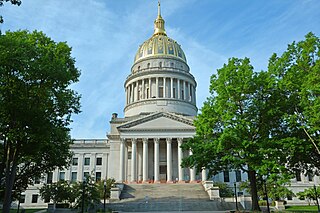
The West Virginia State Capitol is the seat of government for the U.S. state of West Virginia, and houses the West Virginia Legislature and the office of the Governor of West Virginia. Located in Charleston, West Virginia, the building was dedicated in 1932. Along with the West Virginia Executive Mansion it is part of the West Virginia Capitol Complex, a historic district listed on the National Register of Historic Places.

The Idaho State Capitol in Boise is the home of the government of the U.S. state of Idaho. Although Lewiston briefly served as Idaho's capital from the formation of Idaho Territory in 1863, the territorial legislature moved it to Boise on December 24, 1864.
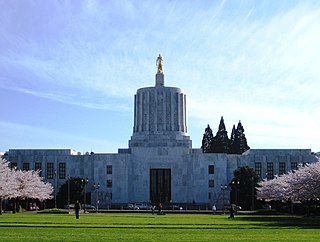
The Oregon State Capitol is the building housing the state legislature and the offices of the governor, secretary of state, and treasurer of the U.S. state of Oregon. It is located in the state capital, Salem. Constructed from 1936 to 1938 and expanded in 1977, the current building is the third to house the Oregon state government in Salem. The first two capitols in Salem were destroyed by fire, one in 1855 and the other in 1935.

The South Carolina State House is the building housing the government of the U.S. state of South Carolina, which includes the South Carolina General Assembly and the offices of the Governor and Lieutenant Governor of South Carolina. Located in the capital city of Columbia near the corner of Gervais and Assembly Streets, the building also housed the Supreme Court until 1971.
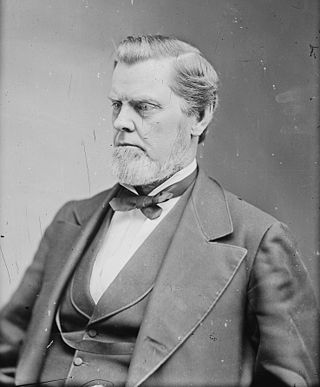
Benjamin Harvey Hill was a politician whose career spanned state and national politics, and the Civil War. He served in the Georgia legislature in both houses. Although he had opposed secession in 1860, he represented Georgia as a Confederate senator during the conflict.

The Michigan State Capitol is the building that houses the legislative branch of the government of the U.S. state of Michigan. It is in the portion of the state capital of Lansing which lies in Ingham County.

Liberty Plaza is a public plaza in downtown Atlanta, Georgia, adjacent to the Georgia State Capitol. Completed in 2015, the 2.2-acre plaza is capable of holding over 3,000 people and has hosted numerous political demonstrations in Atlanta.
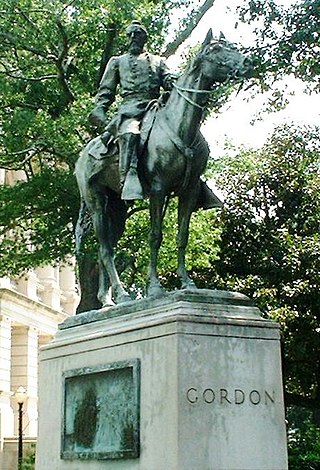
The equestrian statue of John Brown Gordon is a monument on the grounds of the Georgia State Capitol in Atlanta, Georgia, United States. The monument, an equestrian statue, honors John Brown Gordon, a general in the Confederate States Army during the American Civil War who later become a politician in post-Reconstruction era Georgia. Designed by Solon Borglum, the statue was dedicated in 1907 to large fanfare. The statue has recently become a figure of controversy over Gordon's racist views and associations with the Confederacy, with some calling for its removal.

The Martin Luther King Jr. statue is a public monument of civil rights activist Martin Luther King Jr. in Atlanta, Georgia. The statue, designed by Martin Dawe, was unveiled in 2017 and stands on the grounds of the Georgia State Capitol, overlooking Liberty Plaza.
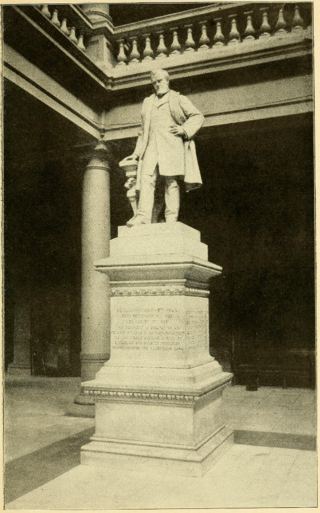
A statue of Benjamin Harvey Hill stands inside the Georgia State Capitol in Atlanta, Georgia, United States. The monumental statue was designed by American sculptor Alexander Doyle and originally dedicated in 1886 at what is now Hardy Ivy Park. The statue was relocated to the capitol building in 1890.































